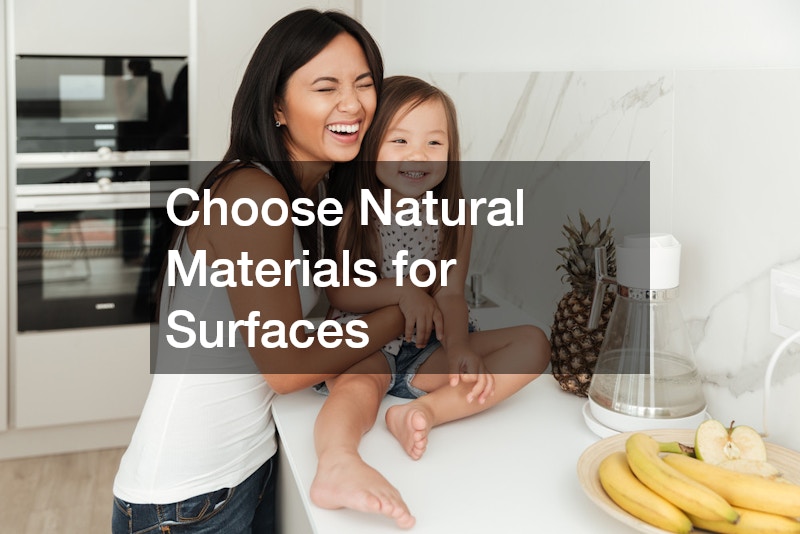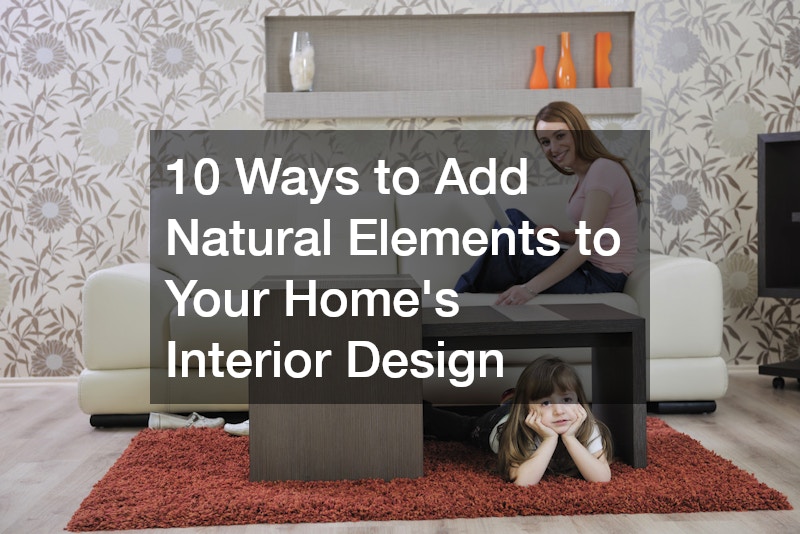Incorporating natural elements into your home’s interior design is a timeless way to create a relaxing, inviting atmosphere. Drawing inspiration from nature not only enhances the aesthetic appeal of your space but also promotes well-being by fostering a connection to the outdoors. From sustainable materials to greenery, small changes can make a big impact on the functionality and beauty of your home.
Whether it’s adding quartz countertops for a sleek, organic feel, using greenery to purify the air, or partnering with professionals like a cabinet maker to craft custom wooden accents, there are countless ways to bring nature into your home. Functional upgrades, like maintaining your HVAC system with AC repair, can further enhance your living environment by ensuring fresh, clean air.
This guide explores ten simple and effective ways to infuse natural elements into your home’s interior design, helping you transform your space into a serene, eco-friendly retreat.
Choose Natural Materials for Surfaces

Incorporating natural materials into your home’s surfaces is a simple yet impactful way to bring organic beauty indoors. By choosing materials like quartz countertops and sustainable flooring, you can create a timeless and functional design.
-
Quartz Countertops for Elegance and Durability
- Quartz countertops are a perfect choice for adding a natural, sleek aesthetic to your kitchen or bathroom.
- Unlike natural stone, quartz is non-porous and resistant to stains, making it a low-maintenance option.
- Available in a wide range of colors and patterns, quartz can mimic the look of marble, granite, or other natural stones.
- Pair quartz countertops with wooden or stone backsplashes for a cohesive, nature-inspired look.
-
Sustainable Flooring for Organic Appeal
- Opt for wood, bamboo, or stone flooring to add warmth and texture to your interiors.
- Layer rugs made from natural fibers like jute or wool for added comfort and style.
- Incorporate carpet repair services to maintain the integrity of existing natural fiber carpets, reducing waste.
-
Benefits of Natural Surfaces
- Natural materials are not only aesthetically pleasing but also environmentally friendly.
- They add durability and timeless charm, increasing the overall value of your home.
Bring in Natural Light
Maximizing natural light in your home is one of the easiest and most effective ways to create a warm, inviting atmosphere. By working with an interior contractor and using thoughtful design strategies, you can transform dark spaces into bright, nature-inspired interiors.
-
Maximize Window Space
- Install large windows, skylights, or glass doors to flood your home with sunlight.
- Collaborate with an interior contractor to remove unnecessary walls or expand existing windows for better light flow.
- Use sheer curtains or light-filtering blinds to maintain privacy without blocking sunlight.
-
Strategic Use of Mirrors
- Place mirrors opposite windows to reflect natural light and make rooms feel larger and brighter.
- Use decorative mirrors with wooden or metal frames for added character that complements a natural design theme.
-
Enhance with Eco-Friendly Artificial Lighting
- Combine natural light with eco-friendly lighting solutions.
- Work with an interior contractor to install recessed lighting or pendant fixtures in areas with limited sunlight.
- Choose LED bulbs that mimic the warmth of natural daylight for seamless integration.
-
Brighten Up with Light Colors
- Use light-colored walls, furniture, and décor to amplify natural light and create an airy feel.
- Complement this palette with natural textures, such as wooden accents or greenery.
Add Greenery and Plant Life

Introducing greenery into your home is an excellent way to infuse life and natural beauty into your interior design. Whether through potted plants or more elaborate installations, plants can instantly refresh your space. With help from a local electrician, you can also ensure proper lighting and irrigation for your greenery.
-
Decorate with Easy-to-Care-For Plants
- Start with low-maintenance options like snake plants, pothos, or peace lilies, which thrive in most indoor conditions.
- Use decorative pots made from natural materials like clay, ceramic, or woven fibers to blend with your home’s aesthetic.
- Group plants of varying heights for visual interest in corners, shelves, or tabletops.
-
Install Vertical Gardens or Living Walls
- Vertical gardens are a stunning way to maximize greenery in small spaces.
- Consult with a local electrician to install grow lights or automatic watering systems for optimal plant care.
- Use native or easy-to-maintain plants to create a lush, low-maintenance wall feature.
-
Enhance Your Home’s Air Quality
- Many plants, such as ferns and rubber plants, act as natural air purifiers, improving indoor air quality.
- Position greenery near windows for natural light or supplement with strategically placed grow lights installed by a local electrician.
-
Blend Greenery with Natural Décor
- Pair plants with organic textures like wood and stone to create a cohesive, nature-inspired look.
Incorporate Organic Textures
Organic textures are a key element in creating a nature-inspired home. Materials like wood, stone, and natural fibers add warmth, depth, and character to your interiors. Collaborating with a skilled cabinet maker can help you incorporate these elements seamlessly into your design.
-
Custom Wooden Features
- Work with a cabinet maker to design custom wooden cabinets, shelves, or furniture.
- Use reclaimed or sustainably sourced wood to enhance the natural look and reduce environmental impact.
- Consider adding visible grain patterns or hand-crafted details for an earthy, artisanal touch.
-
Natural Fiber Textiles
- Incorporate organic fabrics like cotton, jute, or linen for curtains, throw pillows, or rugs.
- Use textured throws or woven baskets as functional and decorative elements.
-
Stone and Ceramic Accents
- Add natural stone features, such as countertops, backsplashes, or decorative bowls.
- Mix in ceramic vases or planters for added texture and charm.
-
Layer Textures for a Cozy Atmosphere
- Combine different materials, such as a wooden coffee table with a jute rug, for a balanced look.
- Use neutral colors to let the natural textures stand out.
Upgrade Kitchens with Earthy Touches

The kitchen is the heart of your home and an ideal space to incorporate natural elements. By combining earthy materials and functional upgrades like oven repair, you can create a warm, nature-inspired cooking and dining area.
-
Earthy Kitchen Designs
- Use wooden open shelves or natural stone backsplashes to add organic textures.
- Opt for a neutral color palette with earth tones like beige, green, or soft browns for cabinets and walls.
- Include potted herbs on windowsills or counters for a touch of greenery and a fresh cooking ingredient.
-
Ensure Functional Appliances
- Schedule oven repair and other appliance maintenance to keep your kitchen running smoothly.
- Regular upkeep ensures energy efficiency and prolongs the life of your appliances.
-
Sustainable and Stylish Materials
- Incorporate bamboo or reclaimed wood for cutting boards, serving trays, or utensil holders.
- Choose eco-friendly options for flooring, countertops, and cabinets that mimic natural materials.
-
Lighting for Ambiance
- Add pendant lights with rattan or wooden shades to complement the natural theme.
- Install dimmable options to adjust the atmosphere for cooking or dining.
Create Cozy, Natural Spaces
Crafting cozy, natural spaces in your home is key to making it a warm and inviting retreat. By focusing on comfort, functionality, and natural materials, you can design areas that reflect the tranquility of the outdoors. Practical features like a whole house generator ensure these spaces remain comfortable in any situation.
-
Relaxation Zones with Natural Touches
- Use plush seating, soft throws, and cushions made from organic fabrics to create a welcoming atmosphere.
- Incorporate wooden coffee tables, wicker chairs, or stone accents for an earthy aesthetic.
-
Add Functional Comfort
- Install a whole house generator to ensure uninterrupted power for essential areas, especially during storms or outages.
- Reliable power supports heating, cooling, and lighting in your cozy spaces year-round.
-
Layered Lighting for Ambiance
- Use warm, dimmable lights with natural finishes, like wooden or woven shades.
- Combine lighting with candles or fireplaces to enhance the cozy, natural vibe.
-
Natural Rugs and Décor
- Include area rugs made from jute, wool, or sisal to add texture and warmth.
- Decorate with potted plants, dried flowers, or nature-inspired art to bring the outdoors in.
Enhance Indoor Air Quality
Good air quality is essential for creating a healthy and comfortable home. By integrating natural solutions and maintaining your HVAC system with regular AC repair, you can ensure your indoor spaces are fresh, clean, and conducive to well-being.
-
Maintain Your HVAC System
- Schedule regular AC repair and servicing to keep your air conditioning system running efficiently.
- Clean filters and ducts to reduce dust, allergens, and other pollutants in your home.
- Ensure proper ventilation to maintain consistent airflow and a pleasant indoor environment.
-
Incorporate Natural Air Purifiers
- Add air-purifying plants like spider plants, peace lilies, or bamboo palms to your décor.
- Use natural materials like Himalayan salt lamps or activated charcoal bags to further improve air quality.
-
Maximize Fresh Air Flow
- Open windows regularly to allow fresh air circulation.
- Use ceiling or oscillating fans to complement your HVAC system, especially during mild weather.
-
Design for Better Ventilation
- Arrange furniture to avoid blocking air vents or windows.
- Consult an HVAC professional to optimize airflow throughout your home.
Use Nature-Inspired Color Palettes
Incorporating nature-inspired color palettes is a subtle yet impactful way to bring the outdoors into your home. From earthy tones to soft neutrals, these colors create a calming atmosphere that complements modern and traditional kitchen designs and other spaces in your home.
-
Earthy Tones for a Natural Feel
- Use greens, browns, and beiges to mimic natural landscapes. These colors work especially well in kitchen designs, bringing warmth and a grounded feel to the space.
- Incorporate accent pieces like green backsplash tiles or natural wood cabinetry for added depth.
-
Neutral Shades for Versatility
- Opt for whites, grays, and soft blues as a base for walls and larger furniture.
- Pair these neutrals with organic textures like stone countertops or wooden beams to create a cohesive look.
-
Accent Walls for a Bold Touch
- Paint an accent wall in rich forest green, navy blue, or terracotta to make a statement.
- Use wallpaper with botanical patterns to add visual interest without overwhelming the space.
-
Color Coordination in Kitchens
- Align your color palette with natural materials like quartz countertops or reclaimed wood.
- Blend earthy hues into kitchen designs by pairing neutral cabinets with green or brown tones in backsplash tiles.
Prioritize Sustainability
Incorporating sustainability into your home’s design not only benefits the environment but also adds a sense of responsibility and purpose to your living spaces. From using eco-friendly materials to maintaining existing features through services like carpet repair, sustainable practices can enhance your home’s aesthetic and functionality.
-
Use Sustainable Materials
- Opt for reclaimed wood, recycled glass, or bamboo for furniture, flooring, and décor.
- Choose natural fibers like wool or jute for rugs, curtains, and upholstery.
-
Extend the Life of Existing Features
- Instead of replacing damaged rugs, consider carpet repair services to restore them to their original condition.
- Repair instead of discarding furniture to reduce waste and maintain sentimental or aesthetic value.
-
Invest in Energy Efficiency
- Upgrade to energy-efficient appliances and lighting to reduce utility costs and environmental impact.
- Seal windows and doors to improve insulation and reduce heating and cooling demands.
-
Repurpose and Upcycle
- Transform old or unused items into functional décor, such as turning vintage crates into shelving units.
- Work with local artisans to repurpose materials into unique, one-of-a-kind pieces.
Seamlessly Blend Indoor and Outdoor Spaces
Blurring the boundaries between indoor and outdoor spaces can transform your home into a cohesive retreat that fully embraces nature. Through thoughtful design choices and practical solutions like permanent lighting services, you can create a seamless transition between the two environments.
-
Design with Continuity
- Use similar materials and color palettes indoors and outdoors, such as wood, stone, or earthy tones, for a harmonious look.
- Incorporate large sliding glass doors or foldable windows to connect interior spaces with patios or gardens.
-
Create Functional Outdoor Living Areas
- Design outdoor kitchens, seating areas, or dining spaces that complement your interior layout.
- Equip these spaces with weather-resistant furniture and accessories for durability and style.
-
Enhance Lighting for Ambiance and Functionality
- Use permanent lighting services to install fixtures that illuminate pathways, patios, and indoor-outdoor connections.
- Choose warm, eco-friendly lighting options to create a natural and inviting ambiance at night.
-
Add Greenery for Continuity
- Place potted plants or vertical gardens near windows and doors to visually connect your indoor and outdoor spaces.
- Use similar plant species inside and outside for a cohesive natural aesthetic.
Conclusion: Bringing Nature Into Your Home
Incorporating natural elements into your home’s interior design creates a serene, beautiful, and functional living space. From quartz countertops and greenery to sustainable practices like carpet repair, every detail can enhance your connection to the outdoors while adding value to your home. By focusing on features like natural textures, earthy color palettes, and seamless indoor-outdoor transitions supported by permanent lighting services, you can design a home that is both stylish and eco-friendly. These simple yet impactful changes not only improve aesthetics but also promote well-being, making your home a true haven inspired by the beauty of nature.



